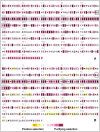Maintenance of sex-related genes and the co-occurrence of both mating types in Verticillium dahliae
- PMID: 25383550
- PMCID: PMC4226480
- DOI: 10.1371/journal.pone.0112145
Maintenance of sex-related genes and the co-occurrence of both mating types in Verticillium dahliae
Abstract
Verticillium dahliae is a cosmopolitan, soilborne fungus that causes a significant wilt disease on a wide variety of plant hosts including economically important crops, ornamentals, and timber species. Clonal expansion through asexual reproduction plays a vital role in recurring plant epidemics caused by this pathogen. The recent discovery of recombination between clonal lineages and preliminary investigations of the meiotic gene inventory of V. dahliae suggest that cryptic sex appears to be rare in this species. Here we expanded on previous findings on the sexual nature of V. dahliae. Only 1% of isolates in a global collection of 1120 phytopathogenic V. dahliae isolates contained the MAT1-1 idiomorph, whereas 99% contained MAT1-2. Nine unique multilocus microsatellite types comprised isolates of both mating types, eight of which were collected from the same substrate at the same time. Orthologs of 88 previously characterized sex-related genes from fungal model systems in the Ascoymycota were identified in the genome of V. dahliae, out of 93 genes investigated. Results of RT-PCR experiments using both mating types revealed that 10 arbitrarily chosen sex-related genes, including MAT1-1-1 and MAT1-2-1, were constitutively expressed in V. dahliae cultures grown under laboratory conditions. Ratios of non-synonymous (amino-acid altering) to synonymous (silent) substitutions in V. dahliae MAT1-1-1 and MAT1-2-1 sequences were indistinguishable from the ratios observed in the MAT genes of sexual fungi in the Pezizomycotina. Patterns consistent with strong purifying selection were also observed in 18 other arbitrarily chosen V. dahliae sex-related genes, relative to the patterns in orthologs from fungi with known sexual stages. This study builds upon recent findings from other laboratories and mounts further evidence for an ancestral or cryptic sexual stage in V. dahliae.
Conflict of interest statement
Figures



References
-
- Weismann A (1889) The significance of sexual reproduction in the theory of natural selection. In: Poulton EB, Schönland S, Shipley AE, editors. Essays upon heredity and kindred biological problems. Oxford: Clarendon. pp. 251–332.
-
- Otto SP (2009) The evolutionary enigma of sex. Am Nat 174: S1–S14. - PubMed
-
- Goddard MR, Godfray HCJ, Burt A (2005) Sex increases the efficacy of natural selection in experimental yeast populations. Nature 434: 636–640. - PubMed
-
- O'Gorman CM, Fuller HT, Dyer PS (2008) Discovery of a sexual cycle in the opportunistic fungal pathogen Aspergillus fumigatus . Nature 457: 471–474. - PubMed
-
- Short DPG, O'Donnell K, Thrane U, Nielsen KF, Zhang N, et al. (2013) Phylogenetic relationships among members of the Fusarium solani species complex in human infections and the descriptions of F. keratoplasticum sp. nov. and F. petroliphilum stat. nov. Fungal Genet Biol 53: 59–70. - PubMed
Publication types
MeSH terms
Substances
LinkOut - more resources
Full Text Sources
Other Literature Sources

